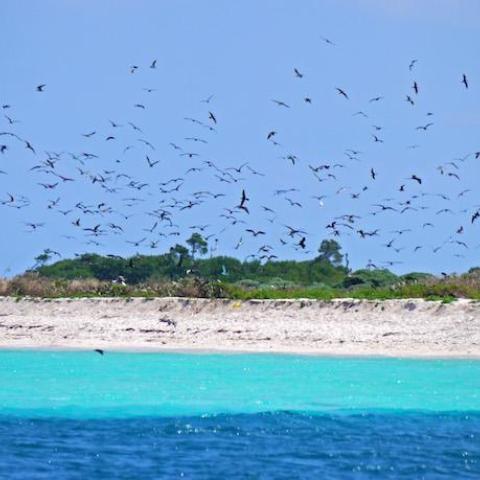
A coral reef in Belize showing dead coral, living healthy elkhorn coral (Acropora palmata), both diseased and healthy symmetrical brain corals (Pseudodiploria strigosa), and a spotfin butterflyfish. Although some fish may benefit from Stony Coral Tissue Loss Disease in the short term, the erosion of dead coral skeletons over time poses a grave threat to reef fish communities/Sara Swaminathan
A coral-killing disease spreading through the Atlantic Ocean waters touching a number of national parks is threatening to upend the marine ecosystem, threatening biodiversity and impacting coastal economies, according to new research from the University of Florida.
Back in 2021 a U.S. Geological Survey marine ecologist warned in an article for the National Parks Traveler that stony coral tissue loss disease was driving a crisis at least on the scale of the 1988 fires that roared across Yellowstone National Park and the continuing invasive insect infestations of hemlocks and other old growth trees in Blue Ridge Parkway and Great Smoky Mountains and Shenandoah national parks.
New findings from Sara Swaminathan, an environmental engineering sciences Ph.D. candidate at the University of Florida, and her colleagues warn that stony coral tissue loss disease is destroying susceptible species of coral in the Caribbean while helping other, “weedier” organisms thrive.
“Some fast-growing organisms, like algae, might thrive in the short term,” said Swaminathan. “But the loss of the susceptible corals could have long-lasting repercussions.”
In her article for the Traveler, Caroline Rogers said the deadly disease was killing more than 20 species of corals. When she wrote the article in 2021, stony coral tissue loss disease was present in national parks in Florida and the Virgin Islands, including Biscayne National Park, Buck Island Reef National Monument, Salt River Bay National Historical Park and Ecological Preserve, Virgin Islands National Park, Virgin Islands Coral Reef National Monument, and Dry Tortugas National Park.
Scientists don’t know what causes the disease, said a release from the University of Florida, but it is thought to be a waterborne pathogen that spreads rapidly across the surface of the coral colony until, in most cases, no living tissue remains.
The university's research team analyzed existing data from the U.S. Virgin Islands as well as data from other U.S. territories in the Caribbean and western Atlantic, including Florida, Puerto Rico, and Dry Tortugas. They examined the effects of stony coral tissue loss disease on fish and benthic reef communities, which comprises anything living on the sea floor, like coral, algae, and sponges.
The team found that the disease not only reduces susceptible coral populations "but also diminishes crustose coralline algae, the resilient pink crust that is crucial for building reef structure. Consequently, certain fast-growing, weedy species, including macroalgae, cyanobacteria, and fire coral, thrive in the absence of competitors, spreading into the vacant spaces left by the decimated corals."
Swaminathan explained that fast-growing species benefitting from the disease create a more seaweed-dominated environment compared to the rock-hard reef structures.
“Macroalgae doesn’t support as much biodiversity because it doesn’t create a hard habitat,” she said. “It might be a positive for herbivores but not for other organisms that need places to settle and grow, hide, or mate.”
The researchers found that the disease’s impact varies among types of fish, and some associations are positive. The study revealed that the rugosity of the coral — the roughness of the habitat — plays more of a factor for the fish than whether the coral is alive or dead.
“Some infectious diseases can affect entire ecosystems, but SCTLD is particularly impactful,” said Kevin Lafferty, a senior scientist with the U.S. Geological Survey and leading expert on marine diseases. “And its impacts are complex, with some winners among the losers.”
Andrew Altieri, an assistant professor in the Herbert Wertheim College of Engineering and associate director of UF’s Center for Coastal Solutions who worked with Swaminathan and others on the research, said “[C]oral reefs are biodiversity hotspots that serve as vital habitats for countless marine species, providing food, shelter, and breeding grounds,” Altieri said. “They are natural protectors of our coastlines, and the loss of these reefs threatens the livelihoods of coastal communities dependent on fishing and tourism. We need to protect and preserve them.”




 Support Essential Coverage of Essential Places
Support Essential Coverage of Essential Places







Comments
Yellowstone has done almost nothing to mitigate the conditions that led to the 1988 fire..
And I strongly suspect the worldwide die off of coral has a lot to do with Japan dumping nuclear waste into the ocean...